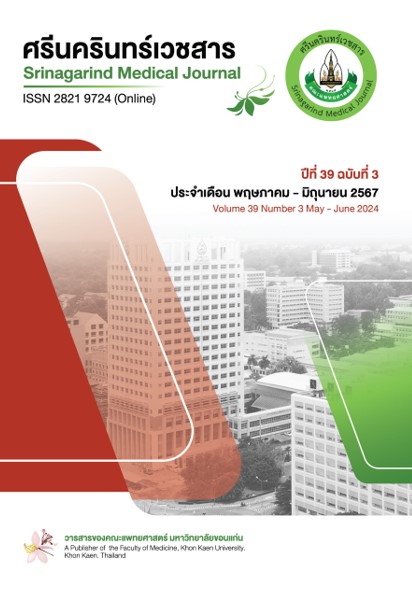Effect of Etomidate Used as Induction Drug for Emergency Intubation on Post Intubation Hypotension in Elderly Patients
Keywords:
elderly, emergency intubation, emergency department, etomidate, post intubation hypotensionAbstract
Background and Objective: Emergency tracheal intubation is a common lifesaving treatment in the emergency department, rapid sequence intubation is the standard method for performing this procedure. Etomidate is an induction drug which is commonly used due to minimal hemodynamic disturbance and having a short duration; however, the evidence of adverse effects in elderly patients are limit. The objective of this study was to evaluate the effect of etomidate used as induction drug for emergency intubation in elderly patients and post intubation hypotension.
Methods: This was a retrospective study in elderly patients who were intubated in the emergency department. The enrolled patients were divided into etomidate used group and non-etomidate used group according to induction drugs used for intubation. The primary outcome was post intubation hypotension and secondary outcomes included the initiation or increased doses of vasopressors within 24 hours, the initiation of hydrocortisone within 24 hours and in hospital mortality.
Results: A total of 231 elderly patients were enrolled in this study, 118 patients were in etomidate used group and 113 patients were in non-etomidate used group. In etomidate used group, 29 patients developed post intubation hypotension and 18 patients in non-etomidate used group experienced post intubation hypotension. Multivariable logistic regression showed no statistically significant association of etomidate used and post intubation hypotension in elderly patients adjusted odds ratio (AOR) 2.10 (0.94-2.71) p=0.070. However, etomidate was associated with the initiation or increased doses of vasopressors within 24 hours, the initiation of hydrocortisone within 24 hours and in hospital mortality.
Conclusions: The study demonstrated that etomidate used was not significantly associated with post intubation hypotension but significantly associated with initiation or increased doses of vasopressors within 24 hours, initiation of hydrocortisone within 24 hours and in hospital mortality in elderly patients.
References
Mohr NM, Pape SG, Runde D, Kaji AH, Walls RM, Brown III CA. Etomidate use is associated with less hypotension than ketamine for emergency department sepsis intubations: a NEAR cohort study. Acad Emerg Med 2020;27(11):1140-9. doi:10.1111/acem.14070.
Wagner RL, White PF, Kan PB, Rosenthal MH, Feldman D. Inhibition of adrenal steroidogenesis by the anesthetic etomidate. N Engl J Med 1984;310(22):1415-21. doi:10.1056/NEJM198405313102202.
Abou Arab O, Fischer MO, Carpentier A, Beyls C, Huette P, Hchikat A, et al. Etomidate-induced hypotension: a pathophysiological approach using arterial elastance. Anaesth Crit Care Pain Med 2019;38(4):347-52. doi:10.1016/j.accpm.2018.12.006.
Acquisto NM, Mosier JM, Bittner EA, Patanwala AE, Hirsch KG, Hargwood P, et al. Society of critical care medicine clinical practice guidelines for rapid sequence intubation in the critically ill adult patient. Crit Care Med 2023;51(10):1411-30. doi:10.1097/CCM.0000000000006000.
Van Berkel MA, Exline MC, Cape KM, Ryder LP, Phillips G, Ali NA, et al. Increased incidence of clinical hypotension with etomidate compared to ketamine for intubation in septic patients: a propensity matched analysis. J Crit Care 2017;38:209-14. doi:10.1016/j.jcrc.2016.11.009.
Leou K, Mendez D, Horani G, Papagiannakis N, Jiménez Sánchez R, Mazzei D, et al. Effects of etomidate on postintubation hypotension, inflammatory markers, and mortality in critically ill patients with COVID-19: an international, multicenter, retrospective study. J Intensive Care Med 2023;38(10):922-30. doi: 10.1177/08850666231173847
Srivilaithon W, Bumrungphanithaworn A, Daorattanachai K, Limjindaporn C, Amnuaypattanapon K, Imsuwan I, et al. Clinical outcomes after a single induction dose of etomidate versus ketamine for emergency department sepsis intubation: a randomized controlled trial. Sci Rep 2023;13(1):6362. doi:10.1038/s41598-023-33679-x.
Koroki T, Kotani Y, Yaguchi T, Shibata T, Fujii M, Fresilli S, et al. Ketamine versus etomidate as an induction agent for tracheal intubation in critically ill adults: a Bayesian meta-analysis. Crit Care 2024;28(1):48. doi:10.1186/s13054-024-04831-4.
Theodosiou CA, Loeffler RE, Oglesby AJ, McKeown DW, Ray DC. Rapid sequence induction of anaesthesia in elderly patients in the emergency department. Resuscitation 2011;82(7):881-5. doi:10.1016/j.resuscitation.2011.02.025
Staheli B, Rondeau B. Anesthetic considerations in the geriatric population. StatPearls [Internet]. Treasure Island (FL): StatPearls Publishing. 2023. [cited Aug 5, 2023]. Available from: https://www.ncbi.nlm.nih.gov/books/NBK572137/
Cicero M, Graneto J. Etomidate for procedural sedation in the elderly: a retrospective comparison between age groups. Am J Emerg Med 2011;29(9):1111-6. doi:10.1016/j.ajem.2010.08.004.
Raksakietisak M, Ngamlamiad C, Duangrat T, Soontarinka S, Raksamani K. The changes in cortisol levels during cardiac surgery: a randomized double-blinded study between two induction agents etomidate and thiopentone. J Med Assoc Thai 2015;98(8):775-81.
Wang F, Yang Z, Zeng S, Gao L, Li J, Wang N. Effects of etomidate combined with dexmedetomidine on adrenocortical function in elderly patients: a double-blind randomized controlled trial. Sci Rep 2022;12(1):12296. doi:10.1038/s41598-022-16679-1.
Bernard R. Fundamentals of biostatistics. 5thed. Duxbery: Thomson learning; 2000.
Smischney NJ, Demirci O, Diedrich DA, Barbara DW, Sandefur BJ, Trivedi S, et al. Incidence of and risk factors for post-intubation hypotension in the critically ill. Med Sci Monit 2016;22:346-55. doi:10.12659/msm.895919.
Mechlin MW, Hurford WE. Emergency tracheal intubation: techniques and outcomes. Respir Care 2014;59(6):881-94. doi:10.4187/respcare.02851.
Kotani Y, Piersanti G, Maiucci G, Fresilli S, Turi S, Montanaro G, et al. Etomidate as an induction agent for endotracheal intubation in critically ill patients: a meta-analysis of randomized trials. J Crit Care 2023;77:154317. doi:10.1016/j.jcrc.2023.154317.
Foster M, Self M, Gelber A, Kennis B, Lasoff DR, Hayden SR, et al. Ketamine is not associated with more post-intubation hypotension than etomidate in patients undergoing endotracheal intubation. Am J Emerg Med 2022;61:131-6. doi:10.1016/j.ajem.2022.08.054.
April MD, Arana A, Schauer SG, Davis WT, Oliver JJ, Fantegrossi A, et al. Ketamine versus etomidate and peri-intubation hypotension: a national emergency airway registry study. Acad Emerg Med 2020;27(11):1106-15. doi:10.1111/acem.14063.
Vinclair M, Broux C, Faure P, Brun J, Genty C, Jacquot C, et al. Duration of adrenal inhibition following a single dose of etomidate in critically ill patients. Intensive Care Medicine 2008;34(4):714-9. doi:10.1007/s00134-007-0970-y.
Downloads
Published
How to Cite
Issue
Section
License
Copyright (c) 2024 Srinagarind Medical Journal

This work is licensed under a Creative Commons Attribution-NonCommercial-NoDerivatives 4.0 International License.




